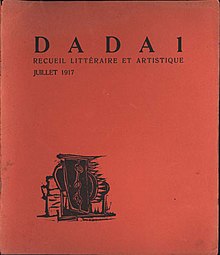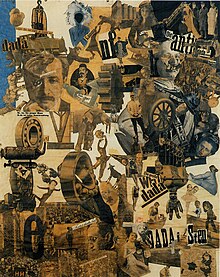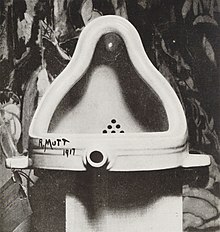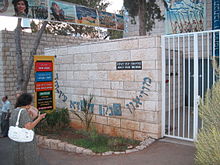Dada or Dadaism is a cultural movement that began in Zurich, Switzerland, during World War I and peaked from 1916 to 1922.[1] To quote Dona Budd's The Language of Art Knowledge, "Dada was born out of negative reaction to the horrors of World War I. This international movement was begun by a group of artists and poets associated with the Cabaret Voltaire in Zurich. Dada rejected reason and logic, prizing nonsense, irrationality and intuition. The origin of the name Dada is unclear; some believe that it is a nonsensical word. Others maintain that it originates from the Romanian artists Tristan Tzara and Marcel Janco's frequent use of the words da, da, meaning yes, yes in the Romanian language. Another theory says that the name "Dada" came during a meeting of the group when a paper knife stuck into a French-German dictionary happened to point to 'dada', a French word for 'hobbyhorse."[2] The movement primarily involved visual arts, literature—poetry, art manifestoes, art theory—theatre, and graphic design, and concentrated itsanti-war politics through a rejection of the prevailing standards in art through anti-art cultural works. Its purpose was to ridicule the meaninglessness of the modern world as its participants saw it. In addition to being anti-war, Dada was also anti-bourgeois and socialist in nature.
Dada activities included public gatherings, demonstrations, and publication of art/literary journals; passionate coverage of art, politics, and culture were topics often discussed in a variety of media. The movement influenced later styles like the avant-garde and downtown musicmovements, and groups including surrealism, Nouveau réalisme, pop art and Fluxus.
Dada is the groundwork to abstract art and sound poetry, a starting point for performance art, a prelude to postmodernism, an influence on pop art, a celebration of antiart to be later embraced for anarcho-political uses in the 1960s and the movement that lay the foundation for Surrealism.

Overview
Dada was an informal international movement, with participants in Europe and North America. The beginnings of Dada correspond to the outbreak of World War I. For many participants, the movement was a protest against the bourgeoisnationalist and colonialist interests, which many Dadaists believed were the root cause of the war, and against the cultural and intellectual conformity—in art and more broadly in society—that corresponded to the war.Many Dadaists believed that the 'reason' and 'logic' of bourgeois capitalist society had led people into war. They expressed their rejection of that ideology in artistic expression that appeared to reject logic and embrace chaos and irrationality. For example, George Grosz later recalled that his Dadaist art was intended as a protest "against this world of mutual destruction."[5]
According to Hans Richter, Dada was not art, it was "anti-art."[4] Everything for which art stood, Dada represented the opposite. Where art was concerned with traditional aesthetics, Dada ignored aesthetics. If art was to appeal to sensibilities, Dada was intended to offend. Through their rejection of traditional culture and aesthetics, the Dadaists hoped to destroy traditional culture and aesthetics.[citation needed]
As Hugo Ball expressed it, "For us, art is not an end in itself ... but it is an opportunity for the true perception and criticism of the times we live in."[6]
A reviewer from the American Art News stated at the time that "Dada philosophy is the sickest, most paralyzing and most destructive thing that has ever originated from the brain of man." Art historians have described Dada as being, in large part, a "reaction to what many of these artists saw as nothing more than an insane spectacle of collective homicide."[7]
Years later, Dada artists described the movement as "a phenomenon bursting forth in the midst of the postwar economic and moral crisis, a savior, a monster, which would lay waste to everything in its path. [It was] a systematic work of destruction and demoralization... In the end it became nothing but an act of sacrilege."[7]

History
Zurich
In 1916, Hugo Ball, Emmy Hennings, Tristan Tzara, Jean Arp, Marcel Janco, Richard Huelsenbeck, Sophie Täuber, and Hans Richter, along with others, discussed art and put on performances in the Cabaret Voltaire expressing their disgust with the war and the interests that inspired it.
Some sources state that Dada coalesced on October 6 at the Cabaret Voltaire. Other sources state that Dada did not originate fully in a Zurich literary salon but grew out of an already vibrant artistic tradition in Eastern Europe, particularly Romania, that transposed to Switzerland when a group of Jewish modernist artists (Tzara, Marcel & Iuliu Iancu, Arthur Segal, and others) settled in Zurich. In the years prior to World War I similar art had already risen in Bucharest and other Eastern European cities; it is likely that DADA's catalyst was the arrival in Zurich of artists like Tzara and Janco.[8]
Having left Germany and Romania during World War I, the artists found themselves in Switzerland, a country recognized for its neutrality. Inside this space of political neutrality they decided to use abstraction to fight against the social, political, and cultural ideas of that time. The dadaists believed those ideas to be a byproduct of bourgeois society, a society so apathetic it would rather fight a war against itself than challenge the status quo.[9]
Marcel Janco recalled,
We had lost confidence in our culture. Everything had to be demolished. We would begin again after the tabula rasa. At the Cabaret Voltaire we began by shocking common sense, public opinion, education, institutions, museums, good taste, in short, the whole prevailing order.
The Cabaret closed its doors in early July and then at the first public soiree at Waag Hall[10] on July 14, 1916, Ball recited the first manifesto. In 1917, Tzara wrote a second Dada manifesto considered one of the most important Dada writings, which was published in 1918. Other manifestos followed.
A single issue of the magazine Cabaret Voltaire was the first publication to come out of the movement.
After the cabaret closed down, activities moved to a new gallery and Hugo Ball left for Bern. Tzara began a relentless campaign to spread Dada ideas. He bombarded French and Italian artists and writers with letters, and soon emerged as the Dada leader and master strategist. The Cabaret Voltaire re-opened, and is still in the same place at the Spiegelgasse 1 in the Niederdorf.
Zurich Dada, with Tzara at the helm, published the art and literature review Dada beginning in July 1917, with five editions from Zurich and the final two from Paris.
When World War I ended in 1918, most of the Zurich Dadaists returned to their home countries, and some began Dada activities in other cities. Others, such as Swiss nativeSophie Täuber, would remain in Zurich into the 1920s.
Berlin
The groups in Germany were not as strongly anti-art as other groups. Their activity and art were more political and social, with corrosivemanifestos and propaganda, satire, public demonstrations and overt political activities. It has been suggested that this is at least partially due to Berlin's proximity to the front, and that for an opposite effect, New York's geographic distance from the war spawned its more theoretically-driven, less political nature.[citation needed]
In February 1918, Huelsenbeck gave his first Dada speech in Berlin, and produced a Dada manifesto later in the year. Hannah Höch andGeorge Grosz used Dada to express post-World War I communist sympathies. Grosz, together with John Heartfield, developed thetechnique of photomontage during this period. The artists published a series of short-lived political magazines, and held the First International Dada Fair, 'the greatest project yet conceived by the Berlin Dadaists', in the summer of 1920.[11] As well as the main members of Berlin Dada, Grosz, Raoul Hausmann, Höch, Johannes Baader, Huelsenbeck and Heartfield, the exhibition also included work by Otto Dix, Francis Picabia, Jean Arp, Max Ernst, Rudolf Schlichter, Johannes Baargeld and others.[11] In all, over 200 works were exhibited, surrounded by incendiary slogans, some of which also ended up written on the walls of the Nazi's Entartete Kunst exhibition in 1937. Despite high ticket prices, the exhibition lost money, with only one recorded sale.[12]
The Berlin group published periodicals such as Club Dada, Der Dada, Everyman His Own Football, and Dada Almanach.

Cologne
In Cologne, Ernst, Baargeld, and Arp launched a controversial Dada exhibition in 1920 which focused on nonsense and anti-bourgeois sentiments. Cologne's Early Spring Exhibition was set up in a pub, and required that participants walk past urinals while being read lewd poetry by a woman in a communion dress. The police closed the exhibition on grounds of obscenity, but it was re-opened when the charges were dropped.
New York
Like Zurich, New York City was a refuge for writers and artists from World War I. Soon after arriving from France in 1915, Marcel Duchamp and Francis Picabia met American artist Man Ray. By 1916 the three of them became the center of radical anti-art activities in the United States. American Beatrice Wood, who had been studying in France, soon joined them, along with Elsa von Freytag-Loringhoven. Arthur Cravan, fleeing conscription in France, was also present for a time. Much of their activity centered in Alfred Stieglitz's gallery, 291, and the home of Walter and Louise Arensberg.
The New Yorkers, though not particularly organized, called their activities Dada, but they did not issue manifestos. They issued challenges to art and culture through publications such as The Blind Man, Rongwrong, and New York Dada in which they criticized the traditionalist basis for museum art. New York Dada lacked the disillusionment of European Dada and was instead driven by a sense of irony and humor. In his book Adventures in the arts: informal chapters on painters, vaudeville and poets Marsden Hartley included an essay on "The Importance of Being 'Dada'".

During this time Duchamp began exhibiting "readymades" (everyday objects found or purchased and declared art) such as a bottle rack, and was active in the Society of Independent Artists. In 1917 he submitted the now famous Fountain, a urinal signed R. Mutt, to the Society of Independent Artists exhibition only to have the piece rejected. First an object of scorn within the arts community, theFountain has since become almost canonized by some. The committee presiding over Britain's prestigious Turner Prize in 2004, for example, called it "the most influential work of modern art."[14] As recent scholarship documents, the work is likely more collaborative than it has been given credit for in twentieth-century art history. Duchamp indicates in a 1917 letter to his sister that a female friend was centrally involved in the conception of this work. As he writes: "One of my female friends who had adopted the pseudonym Richard Mutt sent me a porcelain urinal as a sculpture."[15] The piece is more in line with the scatological aesthetics of Duchamp’s friend and neighbour, the Baroness Elsa von Freytag-Loringhoven, than Duchamp's.[16] In an attempt to "pay homage to the spirit of Dada" a performance artist named Pierre Pinoncelli made a crack in The Fountain with a hammer in January 2006; he also urinated on it in 1993.
Picabia's travels tied New York, Zurich and Paris groups together during the Dadaist period. For seven years he also published the Dada periodical391 in Barcelona, New York City, Zurich, and Paris from 1917 through 1924.By 1921, most of the original players moved to Paris where Dada experienced its last major incarnation (see Neo-Dada for later activity)

Paris
The French avant-garde kept abreast of Dada activities in Zurich with regular communications from Tristan Tzara (whose pseudonym means "sad in country," a name chosen to protest the treatment of Jews in his native Romania), who exchanged letters, poems, and magazines with Guillaume Apollinaire, André Breton, Max Jacob, Clément Pansaers, and other French writers, critics and artists.
Paris had arguably been the classical music capital of the world since the advent of musical Impressionism in the late 19th century. One of its practitioners, Erik Satie, collaborated with Picasso and Cocteau in a mad, scandalous ballet called Parade. First performed by the Ballets Russes in 1917, it succeeded in creating a scandal but in a different way than Stravinsky's Le Sacre du Printemps had done almost five years earlier. This was a ballet that was clearly parodying itself, something traditional ballet patrons would obviously have serious issues with.
Dada in Paris surged in 1920 when many of the originators converged there. Inspired by Tzara, Paris Dada soon issued manifestos, organized demonstrations, staged performances and produced a number of journals (the final two editions of Dada, Le Cannibale, and Littérature featured Dada in several editions.)[17]
The first introduction of Dada artwork to the Parisian public was at the Salon des Indépendants in 1921. Jean Crotti exhibited works associated with Dada including a work entitled,Explicatif bearing the word Tabu. In the same year Tzara staged his Dadaist play The Gas Heart to howls of derision from the audience. When it was re-staged in 1923 in a more professional production, the play provoked a theatre riot (initiated by André Breton) that heralded the split within the movement that was to produce Surrealism. Tzara's last attempt at a Dadaist drama was his "ironic tragedy" Handkerchief of Clouds in 1924.
Netherlands
In the Netherlands the Dada movement centered mainly around Theo van Doesburg, best known for establishing the De Stijl movement and magazine of the same name. Van Doesburg mainly focused on poetry, and included poems from many well-known Dada writers in De Stijl such as Hugo Ball, Hans Arp and Kurt Schwitters. Van Doesburg became a friend of Schwitters, and together they organized the so-called Dutch Dada campaign in 1923, where Van Doesburg promoted a leaflet about Dada (entitled What is Dada?), Schwitters read his poems, Vilmos Huszàr demonstrated a mechanical dancing doll and Nelly Van Doesburg (Theo's wife), played avant-garde compositions on piano.
Van Doesburg wrote Dada poetry himself in De Stijl, although under a pseudonym, I.K. Bonset, which was only revealed after his death in 1931. 'Together' with I.K. Bonset, he also published a short-lived Dutch Dada magazine called Mécano.
Georgia
Although Dada itself was unknown in Georgia until at least 1920, from 1917-1921 a group of poets called themselves "41st Degree" (referring both to the latitude of Tbilisi, Georgia and to the temperature of a high fever) organized along Dadaist lines. The most important figure in this group was Iliazd, whose radical typographical designs visually echo the publications of the Dadaists. After his flight to Paris in 1921, he collaborated with Dadaists on publications and events.
Yugoslavia
In Yugoslavia there was heavy Dada activity between 1920 and 1922 run mainly by Dragan Aleksić and including Mihailo S. Petrov, Zenitist's two brothers Ljubomir Micić and Branko Ve Poljanski. Aleksić used the term "Yugo-Dada" and is known to have been in contact with Raoul Hausmann, Kurt Schwitters, and Tristan Tzara.
Italy
The Dada movement in Italy, based in Mantova, was met with distaste and failed to make a significant impact in the art world. They published a magazine for a short time and held an exhibit in Rome, featuring paintings, Tristan Tzara quotes, and original epigrams such as "True Dada is against Dada". The most notable member of this group was Julius Evola, who went on to become a preeminent occult scholar of the 20th century, as well as a right-wing philosopher and aide to Mussolini.
Tokyo
A prominent Dada group in Japan was MAVO (JA), founded in July 1923 by Tomoyoshi Murayama and Masamu Yanase (DE, JA). Other prominent artists were Jun Tsuji, Eisuke Yoshiyuki, Shinkichi Takahashi (JA) and Katsue Kitasono.
Legacy
While broad, the movement was unstable. By 1924 in Paris, Dada was melding into surrealism, and artists had gone on to other ideas and movements, including surrealism, social realism and other forms of modernism. Some theorists argue that Dada was actually the beginning of postmodern art.[19]
By the dawn of World War II, many of the European Dadaists had emigrated to the United States. Some died in death camps under Adolf Hitler,[citation needed] who persecuted the kind of "Degenerate art" that Dada represented. The movement became less active as post-World War II optimism led to new movements in art and literature.
Dada is a named influence and reference of various anti-art and political and cultural movements including the Situationist Internationaland culture jamming groups like the Cacophony Society.
At the same time that the Zurich Dadaists made noise and spectacle at the Cabaret Voltaire, Vladimir Lenin wrote his revolutionary plans for Russia in a nearby apartment. Tom Stoppard used this coincidence as a premise for his play Travesties (1974), which includes Tzara, Lenin, and James Joyce as characters. French writer Dominique Noguez imagined Lenin as a member of the Dada group in his tongue-in-cheek Lénine Dada (1989).
The Cabaret Voltaire fell into disrepair until it was occupied from January to March, 2002, by a group proclaiming themselves Neo-Dadaists, led by Mark Divo.[20] The group includedJan Thieler, Ingo Giezendanner, Aiana Calugar, Lennie Lee and Dan Jones. After their eviction the space became a museum dedicated to the history of Dada. The work of Lee and Jones remained on the walls of the museum.
Several notable retrospectives have examined the influence of Dada upon art and society. In 1967, a large Dada retrospective was held in Paris, France. In 2006, the Museum of Modern Art in New York City held a Dada exhibition in conjunction with the National Gallery of Art in Washington D.C. and the Centre Pompidou in Paris. The LTM label has released a large number of Dada-related sound recordings, including interviews with artists such as Tzara, Picabia, Schwitters, Arp and Huelsenbeck, and musical repertoire including Satie, Ribemont-Dessaignes, Picabia and Nelly van Doesburg.[21]

Readymades
Marcel Duchamp began to view the manufactured objects of his collection as objects of art, which he called "readymades". He would add signatures and titles to some, converting them into artwork that he called "readymade aided" or "rectified readymades". Duchamp wrote: "One important characteristic was the short sentence which I occasionally inscribed on the 'readymade.' That sentence, instead of describing the object like a title, was meant to carry the mind of the spectator towards other regions more verbal. Sometimes I would add a graphic detail of presentation which in order to satisfy my craving for alliterations, would be called 'readymade aided.'" [24] One such example of Duchamp's readymade works is the urinal that was turned onto its back, signed "R. Mutt", titled "Fountain", and submitted to the Society of Independent Artists exhibition that year.
Hiç yorum yok:
Yorum Gönder